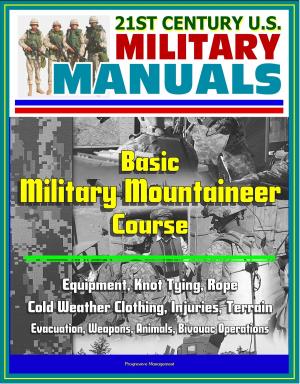Measuring the Immeasurable: An Approach to Assessing the Effectiveness of Engineering Civic Assistance Projects Towards Achieving National Security Objectives - Humanitarian Efforts by World Vision
Nonfiction, Social & Cultural Studies, Political Science, Politics, Social Services & Welfare, History, Military, United States| Author: | Progressive Management | ISBN: | 9780463201879 |
| Publisher: | Progressive Management | Publication: | May 12, 2018 |
| Imprint: | Smashwords Edition | Language: | English |
| Author: | Progressive Management |
| ISBN: | 9780463201879 |
| Publisher: | Progressive Management |
| Publication: | May 12, 2018 |
| Imprint: | Smashwords Edition |
| Language: | English |
This excellent report has been professionally converted for accurate flowing-text e-book format reproduction.
One of the fundamental struggles of U.S. conflicts in the post-World War II era continues to be how to utilize the military instrument of national power as a way to influence people and populations in order to achieve national objectives. In the 2014 Quadrennial Defense Review, Chairman of the Joint Chiefs of Staff, General Dempsey specifies that conducting humanitarian assistance is one of the twelve different ways in which the U.S. military achieves national security objectives. Given this support, there is ever increasing reliance on Humanitarian and Civic Assistance (HCA), specifically engineering civic assistance projects (ENCAPs), as a way to shape the operational environment. Given this increased utilization, assessing their effectiveness towards achieving national security objectives becomes paramount. However, an adequate method of assessment does not exist. The development of such a system will increase the value and effectiveness of ENCAPs given their expanded utilization in a fiscally austere environment that threatens to reduce or eliminate their funding.
CHAPTER 1 INTRODUCTION * Background of the Study * Research Questions * Significance of the Study * Definitions * Methodology * Limitations and Delimitations * Summary * CHAPTER 2 LITERATURE REVIEW * Introduction * What are the objectives of ENCAPs? * What Objectives Have ENCAPs Been Used to Achieve in the Past? * What National Security Objectives Link to ENCAPs? * What Are the Legal and Policy Requirements of ENCAPs? * How Does the Military Assess ENCAPs? * How Does the DoD Currently Assess ENCAPs? * How Has the DoD Assessed ENCAPs in the Past? * What other methods exist for assessing ENCAPs? * Prototype Handbook for Monitoring and Evaluating DoD Humanitarian Assistance Projects * Learning through Evaluation with Accountability and Planning: World Vision's Approach to Design, Monitoring and Evaluation * Evaluation of Humanitarian Action: Pilot Guide * Summary * CHAPTER 3 RESEARCH METHODOLOGY * Introduction * Grounded Theory Methodology * Data Analysis * Data Collection * Role of the Researcher * Limitations and Delimitations * Summary * CHAPTER 4 ANALYSIS * Introduction * Objectives of ENCAPs * Historical Objectives of ENCAPs * ENCAP Objectives as Related to National Security * ENCAP Objectives Required by U.S. Law and DoD Policy * Military Assessment of ENCAPs * Current DoD Assessment Formats * Historical DoD Assessment Formats * Other Existing Methods for Assessing ENCAPs * Prototype Handbook for Monitoring and Evaluating DoD Humanitarian Assistance Projects. * Learning through Evaluation with Accountability and Planning: World Vision's Approach to Design, Monitoring and Evaluation. * Evaluation of Humanitarian Action: Pilot Guide * Core Phenomenon: Lack of Long Term Assessment of ENCAPs * Do ENCAPs Achieve National Security Objectives? * Summary * CHAPTER 5 CONCLUSIONS AND RECOMMENDATIONS * Conclusions * Strategies * Consequences * Recommendations * Proposed Model for Assessing ENCAPs * Recommended Changes to Policy * Areas Warranting Further Research * Closing
This excellent report has been professionally converted for accurate flowing-text e-book format reproduction.
One of the fundamental struggles of U.S. conflicts in the post-World War II era continues to be how to utilize the military instrument of national power as a way to influence people and populations in order to achieve national objectives. In the 2014 Quadrennial Defense Review, Chairman of the Joint Chiefs of Staff, General Dempsey specifies that conducting humanitarian assistance is one of the twelve different ways in which the U.S. military achieves national security objectives. Given this support, there is ever increasing reliance on Humanitarian and Civic Assistance (HCA), specifically engineering civic assistance projects (ENCAPs), as a way to shape the operational environment. Given this increased utilization, assessing their effectiveness towards achieving national security objectives becomes paramount. However, an adequate method of assessment does not exist. The development of such a system will increase the value and effectiveness of ENCAPs given their expanded utilization in a fiscally austere environment that threatens to reduce or eliminate their funding.
CHAPTER 1 INTRODUCTION * Background of the Study * Research Questions * Significance of the Study * Definitions * Methodology * Limitations and Delimitations * Summary * CHAPTER 2 LITERATURE REVIEW * Introduction * What are the objectives of ENCAPs? * What Objectives Have ENCAPs Been Used to Achieve in the Past? * What National Security Objectives Link to ENCAPs? * What Are the Legal and Policy Requirements of ENCAPs? * How Does the Military Assess ENCAPs? * How Does the DoD Currently Assess ENCAPs? * How Has the DoD Assessed ENCAPs in the Past? * What other methods exist for assessing ENCAPs? * Prototype Handbook for Monitoring and Evaluating DoD Humanitarian Assistance Projects * Learning through Evaluation with Accountability and Planning: World Vision's Approach to Design, Monitoring and Evaluation * Evaluation of Humanitarian Action: Pilot Guide * Summary * CHAPTER 3 RESEARCH METHODOLOGY * Introduction * Grounded Theory Methodology * Data Analysis * Data Collection * Role of the Researcher * Limitations and Delimitations * Summary * CHAPTER 4 ANALYSIS * Introduction * Objectives of ENCAPs * Historical Objectives of ENCAPs * ENCAP Objectives as Related to National Security * ENCAP Objectives Required by U.S. Law and DoD Policy * Military Assessment of ENCAPs * Current DoD Assessment Formats * Historical DoD Assessment Formats * Other Existing Methods for Assessing ENCAPs * Prototype Handbook for Monitoring and Evaluating DoD Humanitarian Assistance Projects. * Learning through Evaluation with Accountability and Planning: World Vision's Approach to Design, Monitoring and Evaluation. * Evaluation of Humanitarian Action: Pilot Guide * Core Phenomenon: Lack of Long Term Assessment of ENCAPs * Do ENCAPs Achieve National Security Objectives? * Summary * CHAPTER 5 CONCLUSIONS AND RECOMMENDATIONS * Conclusions * Strategies * Consequences * Recommendations * Proposed Model for Assessing ENCAPs * Recommended Changes to Policy * Areas Warranting Further Research * Closing















